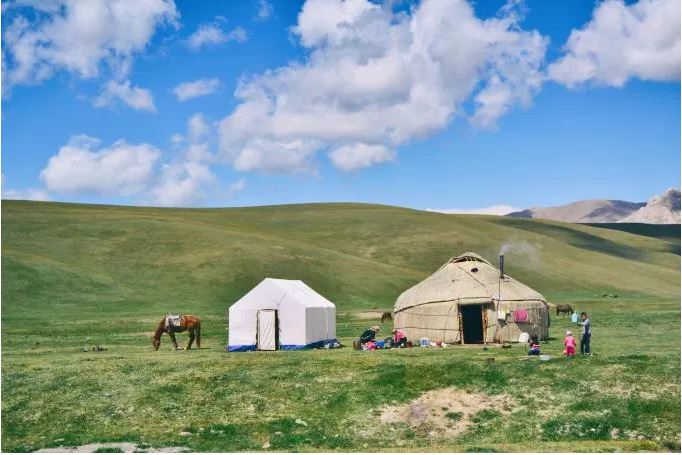
4 min read
Yesterday I featured the video below in my Sunday is for Sharing weekly series.
It’s an 11-minute TED Talk by Anna Rosling Rönnlund. In it, she explains how she sent photographers to 264 homes in 50 countries around the world to document how households in different income brackets live.
Rönnlund’s motivation for doing this project came from her desire to help people understand what type of lifestyle can be had with different income levels around the world.
In her own words,
“People in other cultures are often portrayed as scary or exotic. This has to change. We want to show how people really live. It seemed natural to use photos as data so people can see for themselves what life looks like on different income levels. Dollar Street lets you visit many, many homes all over the world. Without travelling.”
Rönnlund and her team have used all the data and pictures they have gathered so far to create an incredible site called lectures.dollarstreet.org.
The site has a user-friendly layout. At the top you can filter on geography, income level, and photo category. You can then see photos of how different families live. There is even a street with little houses on it to represent household incomes from the lowest to highest per month.
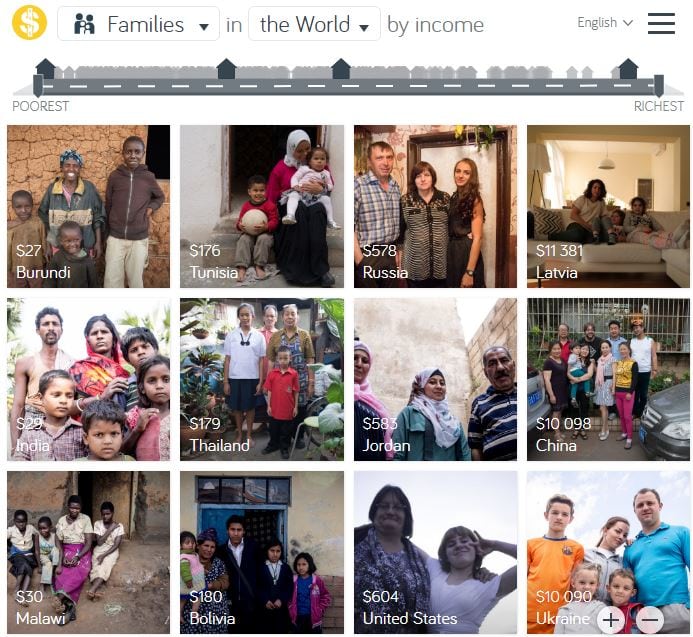
According to Dollar Street, here is how the income levels were calculated:
“The houses are lined up on the street according to their income. Our method for calculating the income of each family tries to measure consumption rather than salary or income, although the data from the families does not always allow this. This means that if a family grow all the rice they eat each month, then the value of this rice will be included in the total consumption of the home.
The “dollars per month” assigned to each home refer to the consumption available to each adult in the family. This means that we take the total consumption and divide it with something called “adult equivalents”, accounting for the fact that young children consume less. Lastly, we measure the value of the consumption in US dollars. Since the cost of living can vary a lot between countries, we use dollars adjusted for purchasing power parity (PPP).”
Some Highlights
I encourage you to check out the site yourself, but here are some interesting findings I came across from spending about an hour on the site myself.
The United States
First I filtered on just U.S. families. It turns out that there is data for 13 different U.S. families (not all shown here).

The lowest income per person per month was $604 and the highest was $4,650. Notice how even the lowest income family falls directly in the middle of the street at the top. That particular family can still afford more goods and services than about half of the families around the world.
Another cool feature of the site is that you can click on the pictures of the families and learn more details about where they live, how many family members they have, etc.
“Next big things I plan to buy”
Next, I took off the U.S. filter and searched all pictures for the category “Next big things I plan to buy”, which gave some eye-opening results:
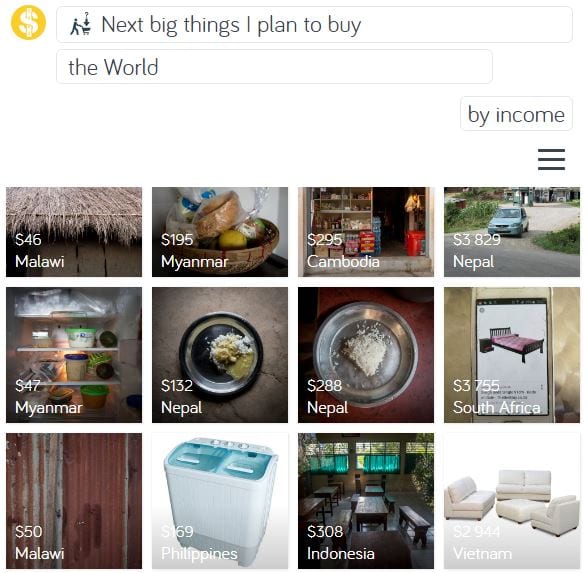
In countries where the income per person per month was below $100, almost all of the “next big things I plan to buy” were things like food, doors, batteries, clothing, or roofing. On the upper end where income was $3,000 + per person per month, the “big things” were often new furniture, cars, iPhones, or computers.
Beds
Next, I searched “beds” for different families around the world.
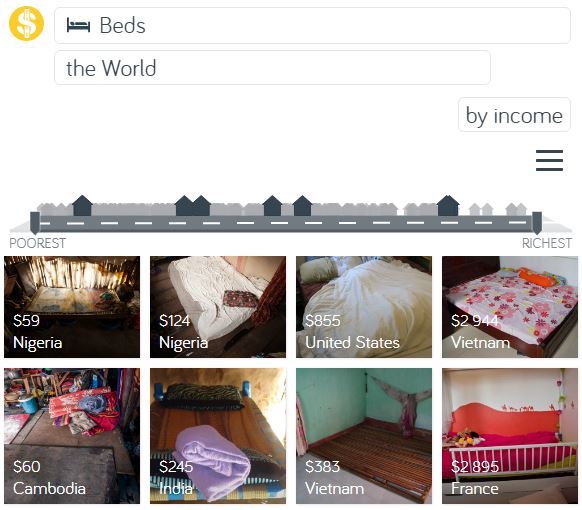
On the lower end of the income scale, the “bed” was almost always a simple mat on a floor. On the upper end of the scale were beds made of fluffy mattresses with plenty of blankets and pillows.
Toilets
Lastly, I searched for “toilets” for different income levels:
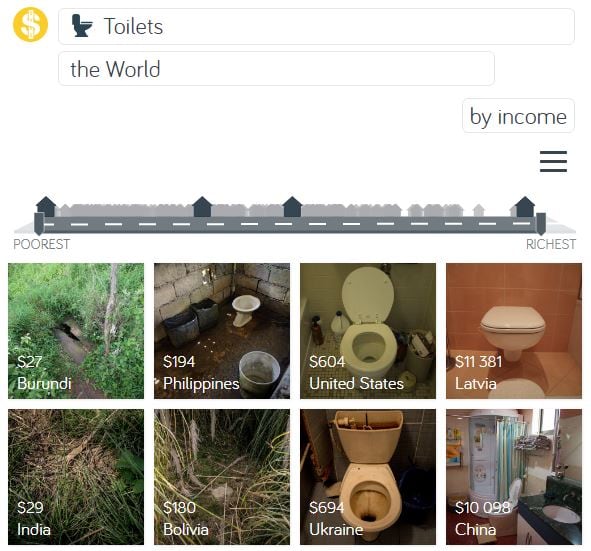
On the low end, most “toilets” were just grassy areas in a forest. On the upper end were traditional indoor toilets inside bathrooms that most of you reading this are probably familiar with.
Gaining a Better Perspective
I could go on and on about different filters I applied and the resulting photos, but I encourage you to check out the site yourself.
It’s truly eye-opening to see how different families live around the world with different income levels. It’s one thing to know that people in different regions have much lower incomes than myself, but it’s another thing entirely to see just what their income can afford them.
More than anything, this site makes me grateful for what I have. Only by sheer luck was I born in the U.S., a developed country with plenty of access to basic amenities, education, and the opportunity to grow my own income and lifestyle.
This site helps me take a step back and acknowledge just how fortunate I am. It helps me see that most of what I take for granted every day are things that people on lower income levels consider “big things” they plan to buy at some point.
I’m excited to see how this project grows over time. There are only 264 families from 50 different countries on the site. I can imagine that the insights and perspectives will be even more mind-blowing when there are pictures and data for 1,000+ families from 100+ countries.
- The Ad Revenue Grid - August 6, 2021
- Attract Money by Creating Value for a Specific Audience - July 13, 2021
- The 5-Hour Workday - March 26, 2021
Full Disclosure: Nothing on this site should ever be considered to be advice, research or an invitation to buy or sell any securities, please see my Terms & Conditions page for a full disclaimer.

Wow! Great post, Zach. Truly eye-opening.
Thanks, Lin! I thought it was worth sharing, glad to hear you found value in it 🙂
That was an awesome site. I love it. I checked Vietnam and Thailand. It’s pretty cheap there. I want to live in that part of the world for a few years later.
The homes on the site is on the cheaper ends. There are a lot nicer places in Thailand now. I hope this site keeps growing.
Pictures are neat, but I also want to take our kid to visit. We need to travel to see how lucky we are in the US.
Weirddd…i mean one potty looks like a nature show and the other toilet looks sci-fi!
Very interesting! Unfortunately, the site won’t load for me, but this seems like a pretty neat compilation.